Mad Hedge Technology Letter
May 7, 2019
Fiat Lux
Featured Trade:
(THE LURKING DANGERS BEHIND FACEBOOK)
(FB), (WFC), (NFLX)
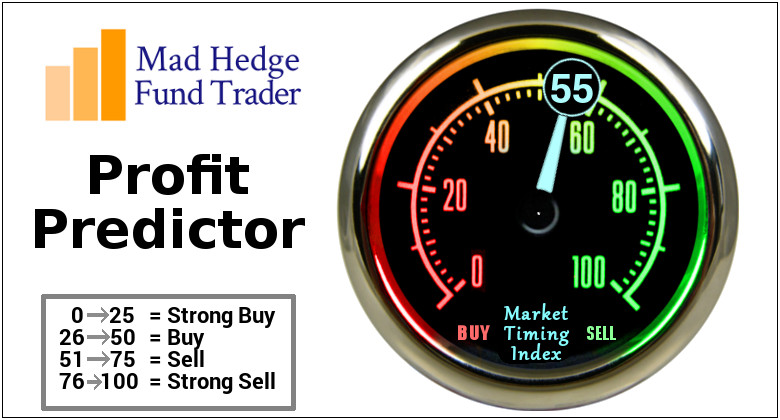
Mad Hedge Technology Letter
May 7, 2019
Fiat Lux
Featured Trade:
(THE LURKING DANGERS BEHIND FACEBOOK)
(FB), (WFC), (NFLX)

The current business model of social media is dead, and the future model seems in doubt – that was the take away from world's largest social media platform at F8 that I attended, its annual developer conference.
Co-founder and CEO Facebook (FB) Mark Zuckerberg stated at the event that “in our digital lives, we also need both public and private spaces,” an impromptu call to action to migrate users into a new private digital world with Facebook dictating the terms.
The sushi must really be hitting the fan for Zuckerberg to announce his future vision of social media, and the writing is on the wall for his current social media experiment, that is, if he continues along at the same rate.
The projected $5 billion fine incurred by Facebook from the Federal Trade Commission over its privacy handling of personal data is peanuts for the social media company, but this could be the first of numerous fines doled out by regional and national regulatory bureaus that span from the Bay Area to Vietnam.
Facebook is a company that made over $55 billion in revenue last year and the $5 billion would amount to less than 10% of annual sales.
From that $55 billion, Facebook earned profits of over $22 billion, and this $22 billion is what the regulatory battles are about, along with the co-founder’s tenacious defense of deploying his users as free content.
The firm has continued to post operating margins of over 40% and delivered margins of 46% last quarter, a sequential rise of 4% in Q4 2018.
The Oracle of Omaha better known as Warren Buffet cited necessitating accountability for CEOs that drive a company into a government bailout especially banks.
He advocated that these executives and their spouses should be stripped of their net worth if they damage shareholder value.
The comments were directed at the way Wells Fargo’s (WFC) former CEO Tim Sloan crippled Wells Fargo and has since been sidelined during the long bull market in equities.
At some point, Zuckerberg could confront similar ructions because of his efforts at perverting democracy that has caused innumerable damage to American democracy and global society, and I am certain his legion of lawyers are already hatching a plan to tackle this thorny predicament.
If you ponder about his announcement in a zero-sum environment, it makes no sense for Facebook to pivot to “private” messages.
This leads me to believe his words are smoke and mirrors so that Facebook can perpetuate its duopoly and force digital ad players to continue to drink from the same Kool-Aid.
As before, Zuckerberg still believes this game of cat and mouse is a half-baked marketing fix.
This is why many of his trusted disciples such as former executive Chris Cox left under a shroud of mystery citing “artistic differences” in terminating his tenure at Facebook.
It is clear to many that Facebook is barreling straight into an even more frightening future.
What does the announcement mean from a business perspective?
Zuckerberg will continue to purge anyone that disagrees with him, even trusted lieutenants, and continue to integrate the family of apps into one big platform that includes Facebook, Instagram, and WhatsApp messenger.
These three will become one and thus, Zuckerberg’s ad machine rolls on like the dystopian action film Mad Max.
Let me remind you, these drastic measures boil down to Facebook doing everything they can to keep content costs down.
If they, for example, have to go the same route as Netflix (NFLX) - overpaying for the best actors and directors to generate premium content, the stock would halve the next day.
And that is what Zuckerberg is desperately hoping to avoid after the 30% dip in shares in 2018 because of regulatory headwinds.
Combining the three apps would be impossible to regulate at a time that regulation is rearing its ugly head.
Zuckerberg is intentionally upping the ante and accruing more risk in the hope that Facebook can outmuscle its way through in one piece.
The ad industry is crying out for something new, but as long as Zuckerberg’s claws are firmly into the meat of the digital ad budgets for most companies, he gets to decide how the industry develops because he knows the ad dollars will stick.
In the future, your private chats won’t be private because Zuckerberg will be mining the data for ad dollar revenue.
No matter what he says, nothing will change unless Facebook goes in an entirely new direction which would inhibit sales.
Until the fines become material, let’s say 70% of annual revenue or something of that nature, a $5 billion hit to the bottom line will not persuade the management to transform their practices.
Expect less privacy, and WhatsApp and Instagram to be heavily monetized through ad promotion and data mining even though Zuckerberg pledging his company won’t hold user data “longer than necessary.”
As for Facebook itself, Zuckerberg can’t throw his baby out with the bathwater and will hope to minimize its deceleration by bundling it with the growth trajectory of WhatsApp and Instagram.
Instead of major structural changes, Zuckerberg continues to beat around the bush saying, “You should expect that we’re not going to store your data in countries where there's weak data protection.”
This is not the crux of the problem and shows Zuckerberg is still paying lip service and not ponying up to reality.
Attaching Facebook and its dying model is not an attractive strategy leading to a slew of executive resignations.
I believe this could all end in calamity for Zuckerberg as he figures piling on more risk onto the elevated risk levels is the right decision making Warren Buffet’s point for him about CEO’s accountability.
Should Zuckerberg refund shareholders if his flight turns into a suicide mission then claims to be an unwitting victim?
And how does he even refund democracy with his apps causing major unrest to society such as killings that occur because of the distribution of fake news on his platforms?
Making a hot potato hotter might work for the short term and if ad dollars stream into WhatsApp and Instagram, Zuckerberg will claim victory.
But at some point, the potato will scald his hands so bad that it will drop.
Your private chats will be the content at the fulcrum of his data broker empire since his “digital town square” approach isn’t working anymore.
The company is utterly incentivized to figure out how to continue this ad revenue carnival because 93% of total revenue last quarter came from digital ads which is up from the prior year when it constituted 89%.
It all sounds like a big brother apocalyptical novel, which we are in, scarily, in putting out this dialogue before the firestorm starts, Facebook wants to normalize, and front runs the craziness of selling your private chat data before it becomes a national issue.
Will regulators shut this down or will they be naïve and turn a blind eye?

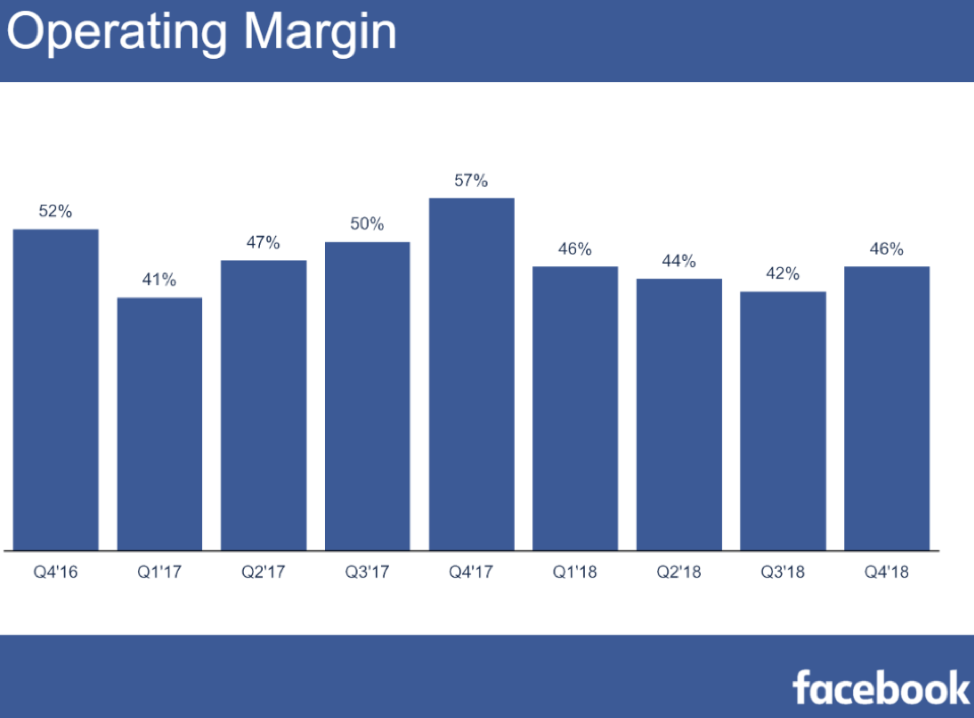
Global Market Comments
March 5, 2019
Fiat Lux
Featured Trade:
(THE BIPOLAR ECONOMY),
(AAPL), (INTC), (ORCL), (CAT), (IBM),
(TESTIMONIAL)
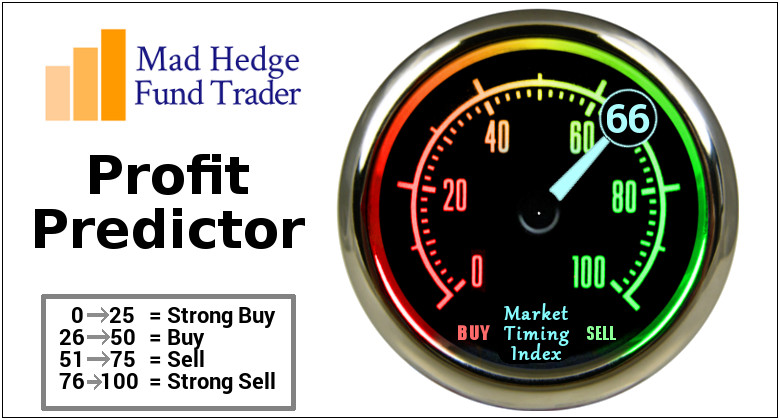
Global Market Comments
March 4, 2019
Fiat Lux
Featured Trade:
(THE MARKET FOR THE WEEK AHEAD, or THE RECESSION HAS BEGUN),
(SPY), (TLT), (GLD), (AAPL)

Global Market Comments
March 1, 2019
Fiat Lux
Featured Trade:
(OH, HOW THE MIGHTY HAVE FALLEN),
(BRK/A), (AXP), (AAPL), (BAC), (KO), (WFC), (KHT),
(AMGEN’S BIG WIN), (AMGN), (SNY), (REGN)

Going through Warren Buffet’s letter to the shareholders of Berkshire Hathaway (BRK/A) you can’t help but notice that his performance nosedived from a breathtaking 21.9% in 2017 to a much more sedentary 2.8% last year. That is with an S&P 500 down -4.4%, including dividends.
That compares to my own 23.67% profit for 2018. But Warren has a much higher bar to reach. He does this with a staggering market capitalization that was pegged at $496 billion as of today. At best, the combined buying power of my Trade Alerts is only about a billion dollars.
And here is the stunning piece of information that should have been the headline. Warren has $112 billion in cash and equivalents, some 22.58% of the total, and an all-time high. That means buying stocks at these levels is the least attractive in the fund’s 57-year history.
Buffet would much rather buy back his own stock. He is willing to pay a premium to book value but only when it trades at a discount to intrinsic value, as he did in size during the fourth quarter of 2018.
Which raises one screaming great question. If Warren Buffet isn’t buying stocks, why should you?
Buffet isn’t even buying Apple, which he only started soaking up in 2017. It now is his second largest holding, with an average cost of $140. I’m amazed that the stock didn’t get crushed on this news, but then we live in a constantly amazing world these days.
The big change in Berkshire Hathaway over the years is that it is becoming more of an operating company and less of an investing one. That is because Buffet is increasingly buying entire companies, rather than exchange-traded stocks. One of the reasons for his cash hoard that an effort to buy a company for high double-digit billions of dollars fell through last year.
Still, Warren bought $43 billion worth of public stocks in 2018 and only sold $19 billion worth. These are his five largest public shareholdings and his percentage of outstanding shares:
American Express (AXP) – 17.9%
Apple (AAPL) – 5.4%
Bank of America (BAC) – 9.5%
Coca-Cola (KO) – 9.4%
Wells Fargo (WFC) – 9.8%
Warren likes to break up his entire holdings into five “groves”, as there are too many companies to follow individually.
1) Wholly owned companies where Berkshire has 80%-100% stakes, such as the BNSF railroad and Berkshire Hathaway Energy.
2) Publicly listed equities like those listed above
3) Companies controlled with third parties, like Kraft Heinz (KHT)
4) US Treasury bills
5) Property/Casualty Insurance operations like GEICO that generate an enormous free cash float
Buffet described the enormous tax benefits his company received from the 2017 tax bill. It amounted to the government’s indirect ownership of Berkshire shares falling, which he humorously calls “AA” shares, from 35% to 21% at no cost whatsoever. That greatly increased the value of the remaining shares.
Warren spent the rest of his letter talking about the Great American Tailwind. Since he started investing on March 11, 1942, one dollar invested in the S&P 500 has grown to an eye-popping $5,288! That works out to an average annualized compound return of 11.8% a year.
The end result has been the greatest creation of wealth and rise in standards of living in human history.
That is a tough record to beat.
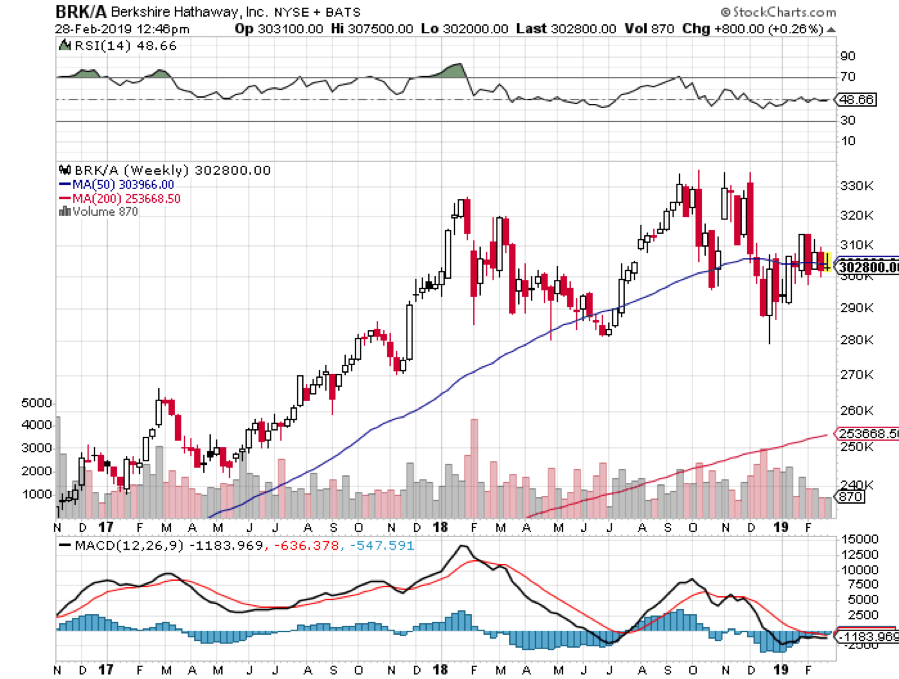

Mad Hedge Technology Letter
January 17, 2019
Fiat Lux
Featured Trade:
(WHY FINTECH IS EATING THE BANKS’ LUNCH),
(WFC), (JPM), (BAC), (C), (GS), (XLF), (PYPL), (SQ), (SPOT), (FINX), (INTU)

Going into January 2018, the big banks were highlighted as the pocket of the equity market that would most likely benefit from a rising rate environment which in turn boosts net interest margins (NIM).
Fast forward a year and take a look at the charts of Bank of America (BAC), Citibank (C), JP Morgan (JPM), Goldman Sachs (GS), and Morgan Stanley (GS), and each one of these mainstay banking institutions are down between 10%-20% from January 2018.
Take a look at the Financial Select Sector SPDR ETF (XLF) that backs up my point.
And that was after a recent 10% move up at the turn of the calendar year.
As much as it pains me to say it, bloated American banks have been completely caught off-guard by the mesmerizing phenomenon that is FinTech.
Banking is the latest cohort of analog business to get torpedoes by the brash tech start-up culture.
This is another fitting example of what will happen when you fail to evolve and overstep your business capabilities allowing technology to move into the gaps of weakness.
Let me give you one example.
I was most recently in Tokyo, Japan and was out of cash in a country that cash is king.
Japan has gone a long way to promoting a cashless society, but some things like a classic sushi dinner outside the old Tsukiji Fish Market can’t always be paid by credit card.
I found an ATM to pull out a few hundred dollars’ worth of Japanese yen.
It was already bad enough that the December 2018 sell-off meant a huge rush into the safe haven currency of the Japanese Yen.
The Yen moved from 114 per $1 down to 107 in one month.
That was the beginning of the bad news.
I whipped out my Wells Fargo debit card to withdraw enough cash and the fees accrued were nonsensical.
Not only was I charged a $5 fixed fee for using a non-Wells Fargo ATM, but Wells Fargo also charged me 3% of the total amount of the transaction amount.
Then I was hit on the other side with the Japanese ATM slamming another $5 fixed fee on top of that for a non-Japanese ATM withdrawal.
For just a small withdrawal of a few hundred dollars, I was hit with a $20 fee just to receive my money in paper form.
Paper money is on their way to being artifacts.
This type of price gouging of banking fees is the next bastion of tech disruption and that is what the market is telling us with traditional banks getting hammered while a strong economy and record profits can’t entice investors to pour money into these stocks.
FinTech will do what most revolutionary technology does, create an enhanced user experience for cheaper prices to the consumers and wipe the greedy traditional competition that was laughing all the way to the bank.
The best example that most people can relate to on a daily basis is the transportation industry that was turned on its head by ride-sharing mavericks Uber and Lyft.
But don’t ask yellow cab drivers how they think about these tech companies.
Highlighting the strong aversion to traditional banking business is Slack, the workplace chat app, who will follow in the footsteps of online music streaming platform Spotify (SPOT) by going public this year without doing a traditional IPO.
What does this mean for the traditional banks?
Less revenue.
Slack will list directly and will set its own market for the sale of shares instead of leaning on an investment bank to stabilize the share price.
Recent tech IPOs such as Apptio, Nutanix and Twilio all paid 7% of the proceeds of their offering to the underwriting banks resulting in hundreds of millions of dollars in revenue.
Directly listings will cut that fee down to $10-20 million, a far cry from what was once status quo and a historical revenue generation machine for Wall Street.
This also layers nicely with my general theme of brokers of all types whether banking, transportation, or in the real estate market gradually be rooted out by technology.
In the world of pervasive technology and free information thanks to Google search, brokers have never before added less value than they do today.
Slowly but surely, this trend will systematically roam throughout the economic landscape culling new victims.
And then there are the actual FinTech companies who are vying to replace the traditional banks with leaner tech models saving money by avoiding costly brick and mortar branches that dot American suburbs.
PayPal (PYPL) has been around forever, but it is in the early stages of ramping up growth.
That doesn’t mean they have a weak balance sheet and their large embedded customer base approaching 250 million users has the network effect most smaller FinTech players lack.
PayPal is directly absorbing market share from the big banks as they have rolled out debit cards and other products that work well for millennials.
They are the owners of Venmo, the super-charged peer-to-peer payment app wildly popular amongst the youth.
Shares of PayPal’s have risen over 200% in the past 2 years and as you guessed, they don’t charge those ridiculous fees that banks do.
Wells Fargo and Bank of America charge a $12 monthly fee for balances that dip below $1,500 at the end of any business day.
Your account at PayPal can have a balance of 0 and there will never be any charge whatsoever.
Then there is the most innovative FinTech company Square who recently locked in a new lease at the Uptown Station in Downtown Oakland expanding their office space by 365,000 square feet for over 2,000 employees.
Square is led by one of the best tech CEOs in Silicon Valley Jack Dorsey.
Not only is the company madly innovative looking to pounce on any pocket of opportunity they observe, but they are extremely diversified in their offerings by selling point of sale (POS) systems and offering an online catering service called Caviar.
They also offer software for Square register for payroll services, large restaurants, analytics, location management, employee management, invoices, and Square capital that provides small loans to businesses and many more.
On average, each customer pays for 3.4 Square software services that are an incredible boon for their software-as-a-service (SaaS) portfolio.
An accelerating recurring revenue stream is the holy grail of software business models and companies who execute this model like Microsoft (MSFT) and Salesforce (CRM) are at the apex of their industry.
The problem with trading this stock is that it is mind-numbingly volatile. Shares sold off 40% in the December 2018 meltdown, but before that, the shares doubled twice in the past two years.
Therefore, I do not promote trading Square short-term unless you have a highly resistant stomach for elevated volatility.
This is a buy and hold stock for the long-term.
And that was only just two companies that are busy redrawing the demarcation lines.
There are others that are following in the same direction as PayPal and Square based in Europe.
French startup Shine is a company building an alternative to traditional bank accounts for freelancers working in France.
First, download the app.
The company will guide you through the simple process — you need to take a photo of your ID and fill out a form.
It almost feels like signing up to a social network and not an app that will store your money.
You can send and receive money from your Shine account just like in any banking app.
After registering, you receive a debit card.
You can temporarily lock the card or disable some features in the app, such as ATM withdrawals and online payments.
Since all these companies are software thoroughbreds, improvement to the platform is swift making the products more efficient and attractive.
There are other European mobile banks that are at the head of the innovation curve namely Revolut and N26.
Revolut, in just 6 months, raised its valuation from $350 million to $1.7 billion in a dazzling display of growth.
Revolut’s core product is a payment card that celebrates low fees when spending abroad—but even more, the company has swiftly added more and more additional financial services, from insurance to cryptocurrency trading and current accounts.
Remember my little anecdote of being price-gouged in Tokyo by Wells Fargo, here would be the solution.
Order a Revolut debit card, the card will come in the mail for a small fee.
Customers then can link a simple checking account to the Revolut debit card ala PayPal.
Why do this?
Because a customer armed with a Revolut debit card linked to a bank account can use the card globally and not be charged any fees.
It would be the same as going down to your local Albertson’s and buying a six-pack, there are no international or hidden fees.
There are no foreign transaction fees and the exchange rate is always the mid-market rate and not some manipulated rate that rips you off.
Ironically enough, the premise behind founding this online bank was exactly that, the originators were tired of meandering around Europe and getting hammered in every which way by inflexible banks who could care less about the user experience.
Revolut’s founder, Nikolay Storonsky, has doubled down on the firm’s growth prospects by claiming to reach the goal of 100 million customers by 2023 and a succession of new features.
To say this business has been wildly popular in Europe is an understatement and the American version just came out and is ready to go.
Since December 2018, Revolut won a specialized banking license from the European Central Bank, facilitated by the Bank of Lithuania which allows them to accept deposits and offer consumer credit products.
N26, a German like-minded online bank, echo the same principles as Revolut and eclipsed them as the most valuable FinTech startup with a $2.7 Billion Valuation.
N26 will come to America sometime in the spring and already boast 2.3 million users.
They execute in five languages across 24 countries with 700 staff, most recently launching in the U.K. last October with a high-profile marketing blitz across the capital.
Most of their revenue is subscription-based paying homage to the time-tested recurring revenue theme that I have harped on since the inception of the Mad Hedge Technology Letter.
And possibly the best part of their growth is that the average age of their customer is 31 which could be the beginning of a beautiful financial relationship that lasts a lifetime.
N26’s basic current account is free, while “Black” and “Metal” cards include higher ATM withdrawal limits overseas and benefits such as travel insurance and WeWork membership for a monthly fee.
Sad to say but Bank of America, Wells Fargo, and the others just can’t compete with the velocity of the new offerings let alone the software-backed talent.
We are at an inflection point in the banking system and there will be carnage to the hills, may I even say another Lehman moment for one of these stale business models.
Online banking is here to stay, and the momentum is only picking up steam.
If you want to take the easy way out, then buy the Global X FinTech ETF (FINX) with an assortment of companies exposed to FinTech such as PayPal, Square, and Intuit (INTU).
The death of cash is sooner than you think.
This year is the year of FinTech and I’m not afraid to say it.
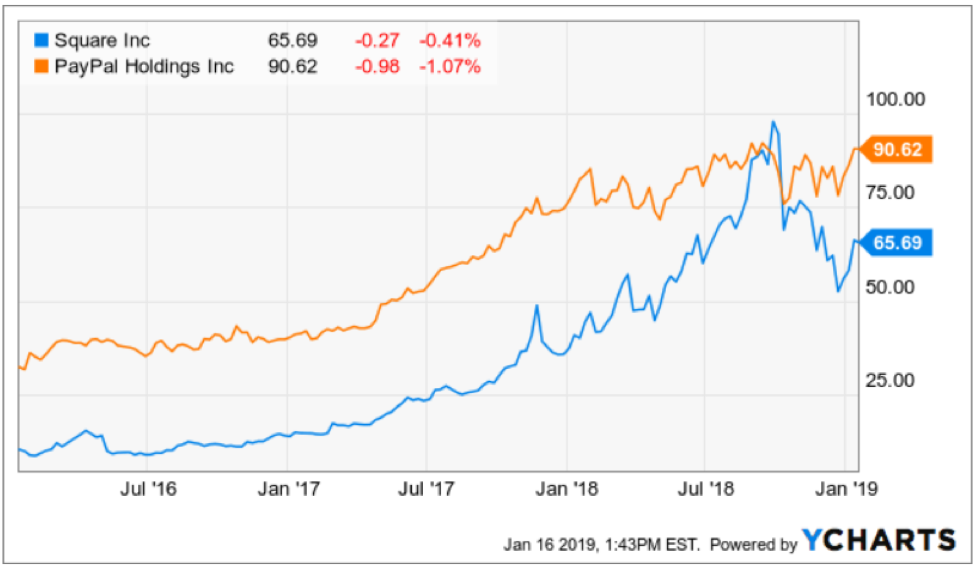
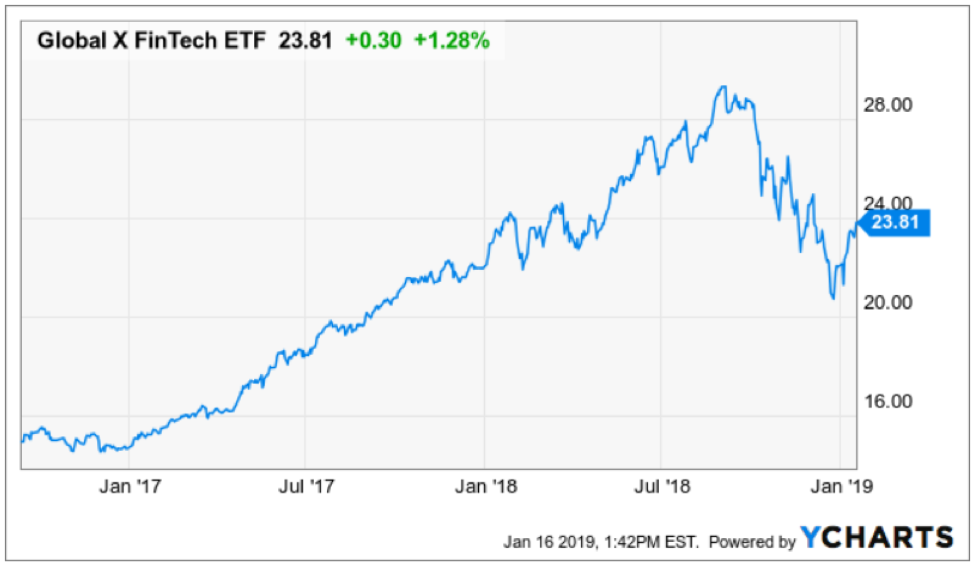
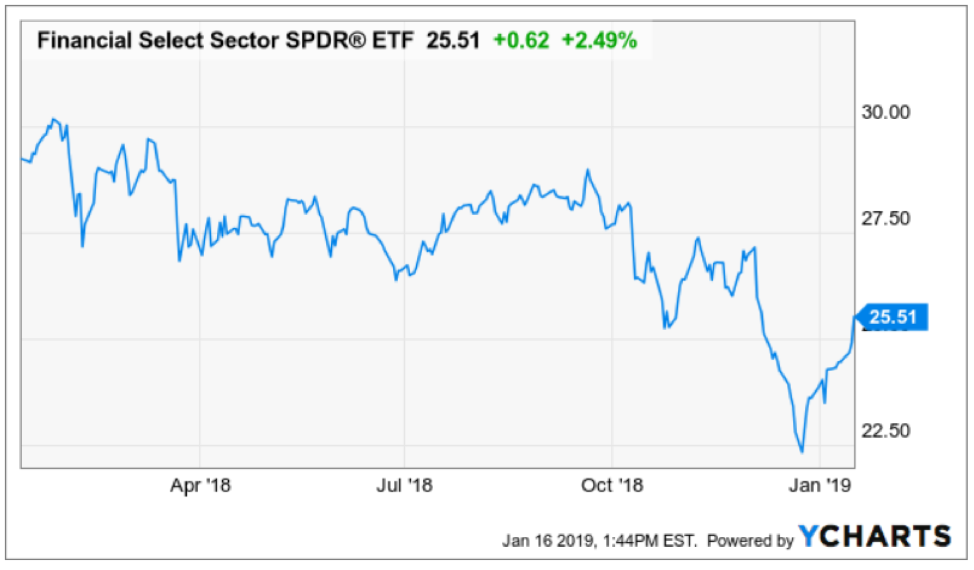
Mad Hedge Technology Letter
September 6, 2018
Fiat Lux
Featured Trade:
(THE SMART PLAYS IN FINTECH),
(SQ), (PYPL), (JPM), (COF), (WFC), (BAC),
(MGI), (GRUB), (BABA), (NFLX)
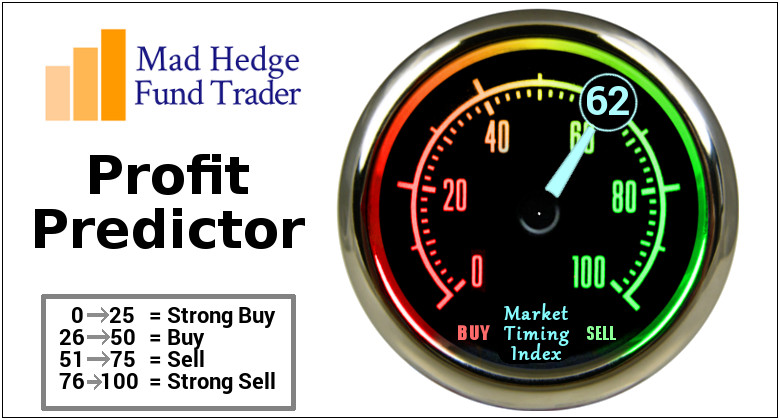
Fintech is all the rage now, and it’s time for investors to grab a piece of the action.
The tech sectors’ stellar performance in 2018 is a little taste of things to come as every industry forcibly pushes toward software and artificial intelligence to enhance products and services.
Bull markets don’t die of old age and some of these tech stalwarts are truly defying gravity.
The fintech sector is no exception.
Square (SQ) led by tech visionary Jack Dorsey has been a favorite of the Mad Hedge Technology Letter practically from the newsletter’s inception.
But another company has caught my eye that most of you already know about – PayPal (PYPL).
PayPal, a digital payments company, has extraordinary core drivers and a splendid growth trajectory.
Its arsenal of services includes digital wallets, money transfers, P2P payments, and credit cards.
It also has Venmo.
Venmo, a digital payment app, is the strongest growth lever in PayPal’s umbrella of assets right now, and was the first meaningful digital payment app in America.
It was established by Andrew Kortina and Iqram Magdon-Ismail, who were roommates at the University of Pennsylvania, and the company was bought out by PayPal for $800 million in 2014, marking a new chapter in PayPal’s evolution.
Funny enough, Venmo’s original use was to buy mp3 formatted songs via email in 2009.
Venmo is wildly popular with tech savvy millennials. A brief survey conducted illustrates how fashionable Venmo is by recording higher user statistics than Apple Pay.
The app is commonly used for ordering pizza through Uber Eats or Grubhub (GRUB), or even shelling out for monthly rent.
If you want to stir up your imagination even more, Venmo has a prominent social feed where users can view other Venmo users’ purchases.
Financial models suggest Venmo could contribute $300 million to the PayPal top line in 2021. If Venmo executes perfectly, revenue could surpass the $1 billion mark in 2021, with much higher operating margins than PayPal’s core products.
Even though management declines to speak specifically about Venmo, the dialogue in the earnings call usually provides some color into what is going on underneath the hood.
Xoom, a digital remittance distributor app with offices in San Francisco and Guatemala City owned by PayPal, along with Venmo grew payment volume by 50% YOY, surging to $33 billion annually.
Of that $33 billion in volume, $19 billion was contributed by Venmo and Xoom chipped in with $14 billion.
More than 60,000 new merchants joined PayPal’s array of platforms, adding up to more than 19.5 million total merchants.
All in all, PayPal locked in $3.86 billion of sales last quarter, which was a 23% YOY jump in revenue, at a time where widespread acceptance of fintech platforms is brisk.
PayPal raised its end-of-year forecast and rewarded shareholders with authorization of a $10 billion buyback.
Upward margin expansion, expanding market share, multiple revenue stream, and untapped pricing power is the recipe to PayPal’s meteoric rise.
PayPal’s share price has climbed higher from a base of $73 at the beginning of the year to an all-time high of more than $90.
Offering more proof fintech is alive and kicking is Jack Dorsey’s Square’s dizzying rise of more than 200% YOY in its share price.
The company is exceeding all revenue growth expectations and is poised to ramp up subscription revenue.
As with the Venmo app, Square’s Cash app has unrealized potential and will be one of the outperforming profit drivers going forward.
Square hopes to be the one-stop-shop for all types of digital payment needs including consumer finance, equity purchases, possibly international transfers, and cryptocurrency.
All of this is happening amid a robust secular story that could have seen traditional banks swept into the dustbin of history.
Rewind a few years ago, perusing the data about the movement to digital payments must have frightened the living daylights out of the executives from major Wall Street mainstays.
Digital wallets assertive migration into mainstream money payment services could have detached traditional banks’ core businesses.
Slogging your way to a physical bank to put in a wire transfer was not appealing.
Archaic methods of business are painful to see, and traditional banks were still operating this way as of 2015.
Time is money and technology has crashed the traditional waiting time to almost zero.
The way these tech companies operate is simple.
They compete to hire a hoard of advanced computer developers or shortcut the process using the time-honored tradition of poaching the competition’s best talent.
Then snatch market share at all costs and grow like crazy.
Banks badly needed introducing some functions to their array of services such as linking with third-party payment APIs to facilitate online payments and enabling cross-platform digital payments.
Other functions such as establishing modern peer-to-peer payment systems or adopting QR code technology that are wildly popular in East Asia could enhance optionality as well.
These are several instruments they could have amalgamated into their arsenal of fintech technology that could have freshened up these dinosaur institutions.
Harmonizing banking tasks with mobile functionality was fast coming and would be the standard.
Anyone not on board would sink like the Titanic.
Ultimately, banking institutions needed to up their game and acquire one of these digital wallet processors or watch from the sidelines.
They chose the former when a consortium called Early Warning Services (EWS) jointly created by behemoth American banks, including JPMorgan Chase & Co. (JPM), Capital One (COF), Bank of America (BAC), and Wells Fargo (WFC) to “prevent fraud and reduce detection risk” made a game-changing decision.
(EWS) acquired digital payment app Zelle in 2016, and this was its aggressive response to Square Cash and PayPal’s Venmo.
Results have been nothing short of breathtaking.
Leveraging the embedded base of existing banking relationships, Zelle took off like a scalded chimp and never looked back.
In a blink of an eye, Zelle had already signed up more than 30 banks and over 100 financial institutions to its platform.
Banks couldn’t bear being left out of the fintech party.
With hearty conviction, Zelle is signing up users at a pace of 100,000 per day, and the volume of payments in 2017 eclipsed $75 billion.
Zelle projects to expand more than 73% in 2018, integrating 27.4 million new accounts in the U.S., head and shoulders above Venmo’s 22.9 million and Square Cash due to add 9.5 million more users.
Make no bones about it, Zelle was in prime position to convert existing relationships into digital converts. The banks that do not have an interest in Zelle have an uphill climb to stay relevant.
The United States is rather late to this secular growth story. That being said, already 57% of Americans have used a mobile wallet at least once in their lives.
Innovative ideas bring supporters galore and even more adoptees.
That is why the strong pivot into technological enhanced ideas bear unlimited fruit.
Using a mobile platform to just open an app then send funds within a split second with minimal costs is appealing for the Netflix (NFLX) crazed generation that can hardly get off the couch.
Ironically, it’s those in the emerging parts of the world leading this fintech revolution by skipping the traditional banking experience completely and downloading digital wallet apps on their mobile devices.
It’s entirely realistic that some fresh-faced youth have never been present at a physical banking branch before in India or China.
Download an app and your fiscal life commences. Period.
The volume of funds passing through the arteries of Chinese digital wallet apps surpassed $15 trillion in 2017.
And by 2021, 79.3% of the Chinese population are projected to use digital wallets as their main source of splurging Chinese yuan.
America lags a country mile behind China, but the Chinese progress has offered American tech companies a crystal-clear blueprint to springboard digital payment initiatives.
Chinese state banks are already starting to become marginalized, and the Wall Street banks are not immune to the same fate.
Devoid of a digital strategy will be a death knell to certain banking institutions.
Compare the pace of adoption and some must question why American adoption is tardy to a fault.
Highlighting the lackadaisical pace of American fintech integration was Alibaba’s (BABA) smash-and-grab attempt at MoneyGram International Inc. (MGI), as it sought to gain a foothold into the American fintech market.
The attempt was rebuffed by the federal government.
The nascent state of the digital payment world in America must alarm Silicon Valley experts. And the run-up in Square and PayPal includes calculated bets that these two standouts will leapfrog into the future with guns blazing along with Zelle.
The parabolic nature of Square’s mystifying gap up means that a moderate pullback is warranted to put capital to work in this name.
Investors should wait for a timely entry point into PayPal as well.
These two stocks have overextended themselves.
As the fintech pie extrapolates, there will be multiple victors, and these victors are already taking shape in the form of Zelle, PayPal, and Square.
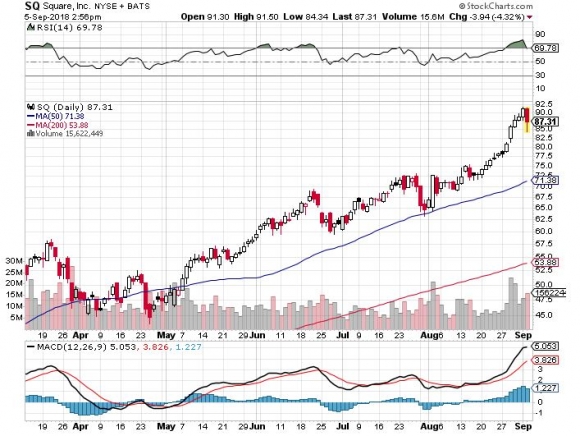
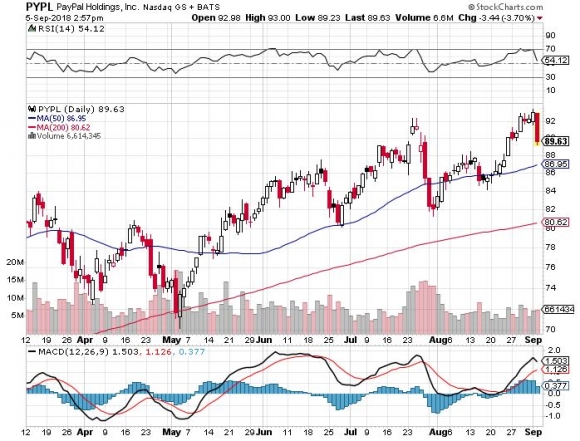
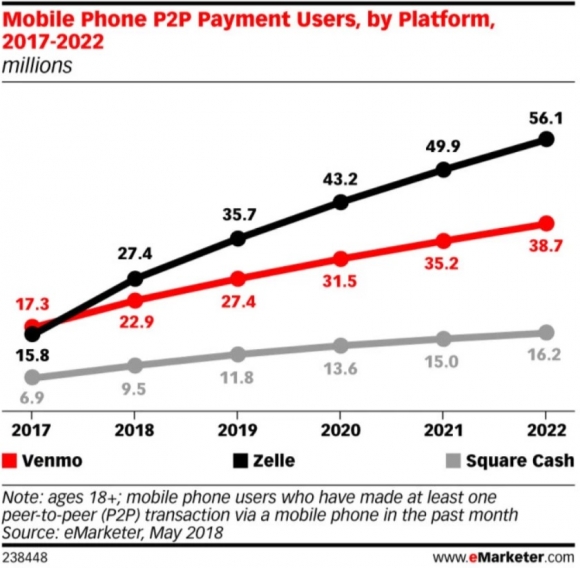
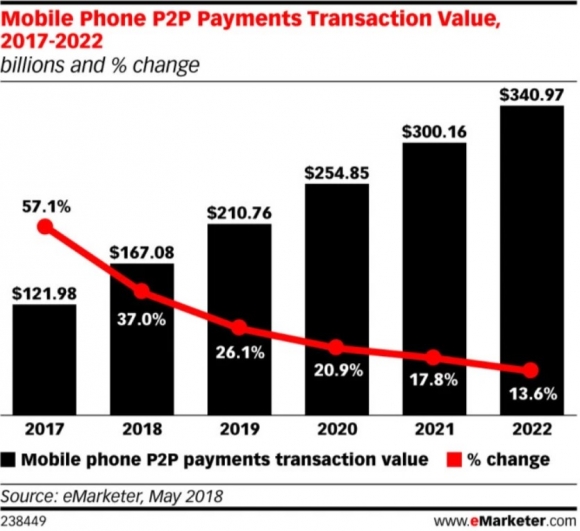
________________________________________________________________________________________________
Quote of the Day
“In the not-too-distant future, commerce is just going to be commerce. It won't be online commerce or offline commerce. It's just going to be commerce. And that will happen because of the phone,” – said CEO of PayPal Dan Schulman.

Legal Disclaimer
There is a very high degree of risk involved in trading. Past results are not indicative of future returns. MadHedgeFundTrader.com and all individuals affiliated with this site assume no responsibilities for your trading and investment results. The indicators, strategies, columns, articles and all other features are for educational purposes only and should not be construed as investment advice. Information for futures trading observations are obtained from sources believed to be reliable, but we do not warrant its completeness or accuracy, or warrant any results from the use of the information. Your use of the trading observations is entirely at your own risk and it is your sole responsibility to evaluate the accuracy, completeness and usefulness of the information. You must assess the risk of any trade with your broker and make your own independent decisions regarding any securities mentioned herein. Affiliates of MadHedgeFundTrader.com may have a position or effect transactions in the securities described herein (or options thereon) and/or otherwise employ trading strategies that may be consistent or inconsistent with the provided strategies.
This site uses cookies. By continuing to browse the site, you are agreeing to our use of cookies.
OKLearn moreWe may request cookies to be set on your device. We use cookies to let us know when you visit our websites, how you interact with us, to enrich your user experience, and to customize your relationship with our website.
Click on the different category headings to find out more. You can also change some of your preferences. Note that blocking some types of cookies may impact your experience on our websites and the services we are able to offer.
These cookies are strictly necessary to provide you with services available through our website and to use some of its features.
Because these cookies are strictly necessary to deliver the website, refuseing them will have impact how our site functions. You always can block or delete cookies by changing your browser settings and force blocking all cookies on this website. But this will always prompt you to accept/refuse cookies when revisiting our site.
We fully respect if you want to refuse cookies but to avoid asking you again and again kindly allow us to store a cookie for that. You are free to opt out any time or opt in for other cookies to get a better experience. If you refuse cookies we will remove all set cookies in our domain.
We provide you with a list of stored cookies on your computer in our domain so you can check what we stored. Due to security reasons we are not able to show or modify cookies from other domains. You can check these in your browser security settings.
These cookies collect information that is used either in aggregate form to help us understand how our website is being used or how effective our marketing campaigns are, or to help us customize our website and application for you in order to enhance your experience.
If you do not want that we track your visist to our site you can disable tracking in your browser here:
We also use different external services like Google Webfonts, Google Maps, and external Video providers. Since these providers may collect personal data like your IP address we allow you to block them here. Please be aware that this might heavily reduce the functionality and appearance of our site. Changes will take effect once you reload the page.
Google Webfont Settings:
Google Map Settings:
Vimeo and Youtube video embeds:
